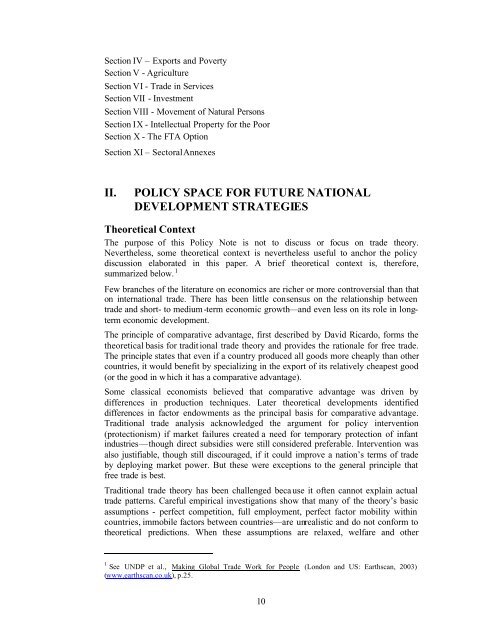Trade Policy Note Final-rev08 - Development
Trade Policy Note Final-rev08 - Development
Trade Policy Note Final-rev08 - Development
Create successful ePaper yourself
Turn your PDF publications into a flip-book with our unique Google optimized e-Paper software.
Section IV – Exports and Poverty<br />
Section V - Agriculture<br />
Section VI - <strong>Trade</strong> in Services<br />
Section VII - Investment<br />
Section VIII - Movement of Natural Persons<br />
Section IX - Intellectual Property for the Poor<br />
Section X - The FTA Option<br />
Section XI – Sectoral Annexes<br />
II.<br />
POLICY SPACE FOR FUTURE NATIONAL<br />
DEVELOPMENT STRATEGIES<br />
Theoretical Context<br />
The purpose of this <strong>Policy</strong> <strong>Note</strong> is not to discuss or focus on trade theory.<br />
Nevertheless, some theoretical context is nevertheless useful to anchor the policy<br />
discussion elaborated in this paper. A brief theoretical context is, therefore,<br />
summarized below. 1<br />
Few branches of the literature on economics are richer or more controversial than that<br />
on international trade. There has been little consensus on the relationship between<br />
trade and short- to medium -term economic growth—and even less on its role in longterm<br />
economic development.<br />
The principle of comparative advantage, first described by David Ricardo, forms the<br />
theoretical basis for tradit ional trade theory and provides the rationale for free trade.<br />
The principle states that even if a country produced all goods more cheaply than other<br />
countries, it would benefit by specializing in the export of its relatively cheapest good<br />
(or the good in which it has a comparative advantage).<br />
Some classical economists believed that comparative advantage was driven by<br />
differences in production techniques. Later theoretical developments identified<br />
differences in factor endowments as the principal basis for comparative advantage.<br />
Traditional trade analysis acknowledged the argument for policy intervention<br />
(protectionism) if market failures created a need for temporary protection of infant<br />
industries—though direct subsidies were still considered preferable. Intervention was<br />
also justifiable, though still discouraged, if it could improve a nation’s terms of trade<br />
by deploying market power. But these were exceptions to the general principle that<br />
free trade is best.<br />
Traditional trade theory has been challenged beca use it often cannot explain actual<br />
trade patterns. Careful empirical investigations show that many of the theory’s basic<br />
assumptions - perfect competition, full employment, perfect factor mobility within<br />
countries, immobile factors between countries—are unrealistic and do not conform to<br />
theoretical predictions. When these assumptions are relaxed, welfare and other<br />
1 See UNDP et al., Making Global <strong>Trade</strong> Work for People (London and US: Earthscan, 2003)<br />
(www.earthscan.co.uk), p.25.<br />
10
















